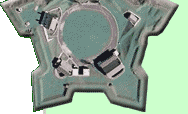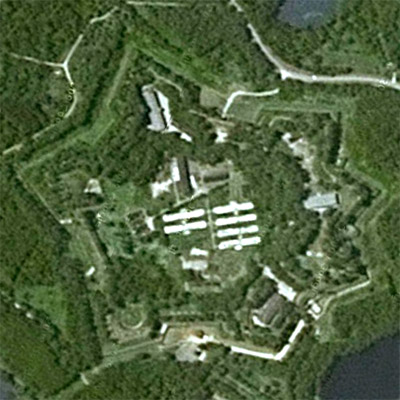
 |
 |
Fortress Boyen Gizycko, Poland |
 |
 |
 |
 |
 |
||
 |
When one looks at a map of today's boundaries, the city of Gizycko sits nestled comfortably in Poland, not too far from the border with Russia. Historically, however, the region has been wrestled over and claimed by different countries, primarily Germany and Russia. This region was known as the State of Teutonic Order after the Teutonic Knights conquered it during a crusade in the 13th century. Gizycko (known to the Germans as Loetzen) was a village that formed around the Teutonic Order's castle, which was built around 1340. Perhaps unhappy with the monastic nature of the Order, Lithuanians invaded the region and destroyed the castle in 1368, but the Teutonic Knights rebuilt it shortly thereafter. The Thirteen Years War (1454-1466) pitted The Prussian Confederation and Kingdom of Poland against the Tuetonic Order. Gizycko and its castle were severly damaged in this conflict, as was the Teutonic Order: The Teutonic Knights remained in control of the region after the war, but were effectively under the control of the King of Poland. The region became secularized in 1525, and the castle became the headquarters of the King's administrator. The town of Gizycko was granted city rights on May 15 1612. The Lord was apparently displeased by the ousting of the Teutonic Knights, and a series of misfortunes followed for Gizycko: In 1657 the city was attacked and burned by Tartars, from 1709 to 1711 the city was decimated by plague and bad crops, and was severly damaged by huge fires in 1756 and 1786. By 1846 Gizycko was firmly in Prussian hands when King Frederick William IV (1795-1861) ordered the construction of a fort, built of earth and bricks, on the site of the castle. The first stone was laid on September 4 1844, and Fortress Boyen got its name from the soon-to-be-deceased Leopold Hermann Ludwig von Boyen (1771-1848), Prussian minister of War and particular proponent of the project. Fortress Boyen was designed to hold 3000 troops (plus 700 carrier pigeons), and its first garrison was formed in 1859. In 1902 the fort became an arsenal for artillery, which was a useful thing to have around indeed, as the First World War (1914-1918) broke out with Gizycko automatically on the front lines. The Russians tried to enter Prussia at the outset of the war, but found Fortress Boyen and other battlements built in the area to be an insurmountable obstacle. German troops used Fort Boyen as a staging area for numerous raids on the Russian army, which assisted the Russians in their decision to forget about their Prussian adventure by the end of August 1914. The war was eventually decided on the Western Front by the arrival of US forces, but Gizycko and its surrounding area remained part of Germany. German forces massed at Fort Boyen just before the beginning of the Second World War (1939-1945), from whence they invaded Poland on September 1 1939...causing Great Britain and France to declare war on Germany, arguably the event kicked the whole thing off in earnest. General Andrey Vlasov (1900-1946) was an up-and-coming Soviet military leader, commander of the 2nd Shock Army that was surrounded and destroyed by the nazis in June of 1942. After fleeing and hiding for 10 days, Vlasov was captured by the Germans and professed his anti-Stalindom. Adolph Hitler (1889-1945), though initially suspicious of Vlasov's intentions, by 1944 was going slightly nuts. Perhaps for this reason he allowed Vlasov to raise the Russian Liberation Army, which did most of its training at Fortress Boyen. Vlasov's army battled the Red Army only once, on the River Oder in February 1945, resulting in Vlasov and his remaining men scampering south to Prague. Vlasov gave permission to one of his commanders to turn his guns against the nazi SS in aid of the Czechs in May 1945, perhaps in an effort to gain favor with the US-led forces approaching from the west, or even the Red Army, rapidly approaching from the east...whatever, Vlasov fled west shortly thereafter to be captured by US forces. When the Red Army reached Gizycko in January 1945, city and Fortress were surrendered without resistance. The Soviets immediately booted out all of Gizycko's Germanish inhabitants, and Poles were brought in to resettle the area. The Polish Army took over Fortress Boyen. In the 1950's the decision was made to use Fortress Boyen as the location for a number of food companies which, as seen in other, similar cases, led to the fort's decline. Darned food-eaters. This sad situation continued into the 1990's, when the food companies were closed down and the fort became a popular tourist attraction. Today, summer festivals are held annually at Fortress Boyen, including the Sailing and Maritime Song Festival. There is a museum on its grounds, as well as meeting places for a vintage motorcycle club and diving club, as well as a youth hostel. |
 |
 |
||
|
|
|||||||
Info Source 1 Info Source 2 Info Source 3 Info Source 4 Info Source 5 Info Source 6 Info Source 7 Info Source 8 Info Source 9 Info Source 10 Thanks to Google Maps for the image! ©2010 starforts.com |
 |